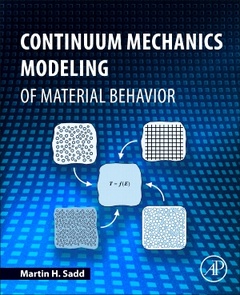Continuum Mechanics Modeling of Material Behavior
Auteur : Sadd Martin H.

Continuum Mechanics Modeling of Material Behavior offers a uniquely comprehensive introduction to topics like RVE theory, fabric tensor models, micropolar elasticity, elasticity with voids, nonlocal higher gradient elasticity and damage mechanics. Contemporary continuum mechanics research has been moving into areas of complex material microstructural behavior. Graduate students who are expected to do this type of research need a fundamental background beyond classical continuum theories. The book begins with several chapters that carefully and rigorously present mathematical preliminaries: kinematics of motion and deformation; force and stress measures; and general principles of mass, momentum and energy balance.
The book then moves beyond other books by dedicating several chapters to constitutive equation development, exploring a wide collection of constitutive relations and developing the corresponding material model formulations. Such material behavior models include classical linear theories of elasticity, fluid mechanics, viscoelasticity and plasticity. Linear multiple field problems of thermoelasticity, poroelasticity and electoelasticity are also presented. Discussion of nonlinear theories of solids and fluids, including finite elasticity, nonlinear/non-Newtonian viscous fluids, and nonlinear viscoelastic materials are also given. Finally, several relatively new continuum theories based on incorporation of material microstructure are presented including: fabric tensor theories, micropolar elasticity, elasticity with voids, nonlocal higher gradient elasticity and damage mechanics.
1. Introduction 2. Mathematical Preliminaries 3. Kinematics of Motion and Deformation Measures 4. Force and Stress 5. General Conservation or Balance Laws 6. Constitutive Relations and Formulation of Classical Linear Theories of Solids and Fluids 7. Constitutive Relations and Formulation of Theories Involving Multiple Constitutive Fields 8. General Constitutive Relations and Formulation of Nonlinear Theories of Solids and Fluids 9. Constitutive Relations and Formulation of Theories Incorporating Material Microstructure
Graduate students majoring in several different technology disciplines including engineering science, mechanics, mechanical, civil, aerospace and materials engineering
- Offers a thorough, concise and organized presentation of continuum mechanics formulation
- Covers numerous applications in areas of contemporary continuum mechanics modeling, including micromechanical and multi-scale problems
- Integration and use of MATLAB software gives students more tools to solve, evaluate and plot problems under study
- Features extensive use of exercises, providing more material for student engagement and instructor presentation
Date de parution : 03-2018
Ouvrage de 432 p.
19x23.4 cm
Thèmes de Continuum Mechanics Modeling of Material Behavior :
Mots-clés :
<; P>; Symmetric Symbols; Isotropic Tensors; Polar Decomposition Theorem; Curvilinear Coordinate Systems; General Tensors; Lagrangian and Eulerian Descriptions; Material Derivative; Deformation Gradient Tensor; Spherical and Deviatoric Strain Tensors; Strain Compatibility; Rotation Tensor; Objective Time Derivatives; Cauchy Stress; Octahedral and vonMises Stress; Piola-Kirchhoff Stress Tensors; Linear Elastic Solids; Ideal Non-Viscous Fluids; Linear Viscous Fluids; Poroelasticity; Electroelasticity; Non-Linear Finite Elasticity; on-Linear Viscous Fluids; Fabric Tensor Theories; Micro-Polar Elasticity; Nonlocal Higher Gradient Theories; Continuum Damage Mechanics<; /P>



